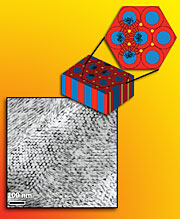- Number 357 |
- February 27, 2012
Berkeley Lab produces nanorods to order

“Block copolymers control
self-assembling nanorod arrays”
Nanorods – rod-shaped crystals of semiconductor materials whose dimensions are measured in mere billionths of a meter – are central to many schemes for solar cells, magnetic storage devices, and sensors that depend on arrays of these crystals in composite with polymers. Only nanorods that can assemble themselves into complex structures and hierarchical patterns can fully realize this technological promise, however.
A new technique developed by researchers at DOE’s Lawrence Berkeley National Laboratory (Berkeley Lab) delivers self-assembling arrays of nanorods with improved mechanical and electrical properties, which can be grown relatively quickly, easily, and inexpensively when combined with polymers.
“Ours is a simple and versatile technique for controlling the orientation of nanorods within block copolymers,” says Ting Xu, a polymer scientist with joint appointments in Berkeley Lab’s Materials Sciences Division, the University of California at Berkeley’s Department of Materials Sciences and Engineering, and UC Berkeley’s Department of Chemistry, who led the research.
Block copolymers are long sequences, or blocks, of one kind of monomer (single chemical units) bound to blocks of another type of monomer. They have an innate ability to self-assemble into well-defined arrays of nanoscale structures over great distances and can act as platforms to guide the self-assembly of nanorods into the necessary patterns and structures.
“By varying the morphology of the block copolymers and the chemical nature of the nanorods,” says Xu, “we can provide the controlled self-assembly in nanorods and nanorod-based nanocomposites that is critical for their use in the fabrication of optical and electronic devices.”
Xu and her research group first used block copolymers to spur self-assembly of spherical particles, known as quantum dots, in 2009, lashing the copolymers to the quantum dots with small adhesive “mediator” molecules. In the present work they again use mediator molecules, this time to control the interaction between the nanorods and groups of molecules called supramolecules, which act as single molecules to perform specific functions.
Xu and her group incorporate the nanorods into solutions of block-copolymer supramolecules that can form spherical, cylindrical, and lamellar microdomains. As the solutions dry, energy from interactions between the nanorod ligands and the polymers determines the placement and distribution of the nanorods, as well as the overall shape of the resulting composites. Energy from these interactions is easily tuned by attaching different kinds of small mediator molecules to the side chains of the supramolecules to vary their shapes.
“We can readily access a wide library of nanorod assemblies, including arrays of nanorods aligned parallel to block copolymer cylindrical microdomains, continuous nanorod networks, and nanorod clusters,” Xu says. “Since the macroscopic alignment of block copolymer microdomains can be obtained in bulk and in thin films by the application of external fields, our technique should open up a viable route to manipulate the macroscopic alignments of nanorods.”
Xu’s group needed high-resolution tomography to study the nanorod assemblies in 3-D, “and this posed a challenge not only for collecting the imaging data but also for processing it,” Xu says. Most of the work was done at the National Center for Electron Microscopy.
“Direct nanorod assembly using block copolymer-based supramolecules,” by Kari Thorkelsson, Alexander J. Mastroianni, Peter Ercius, and Ting Xu, appears in Nano Letters.[Lynn Yarris, 510.486.5375,
lcyarris@lbl.gov]
